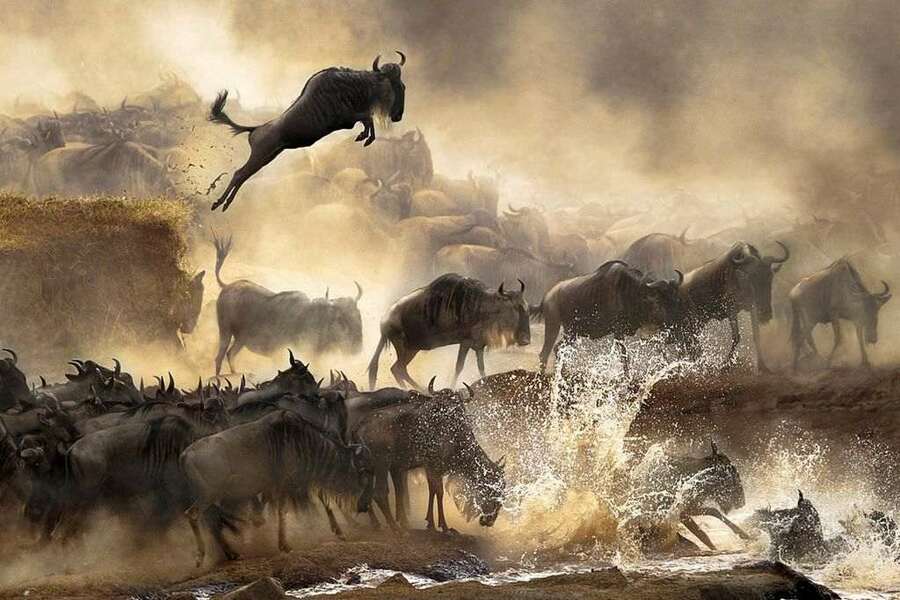On a Serengeti South Safari with Mkama Tours to Tanzania, from December to March, you can follow the wildebeest in at Kusini, in the Serengeti National Park, at Ndutu in the Ngorongoro Conservation Area and on the Maswa Game Reserve. Kusini is spotted with kopjes where cheetahs, leopards and lions abound. The Serengeti cheetah project is based. Mega herds of herbivores gather on the plains to build up their strength as lush grass follows the short rains. When they move on, the area is still rich with wildlife, especially faunas depending on the protective microclimates of kopjes, where water collects in basin-like rocks and predators, including lions and jackals, keep vigil from above to see what prey will come to drink. Bizarre aardvark and pangolin feed from towering termite mounds. African hedgehogs, hares and voles dart around the rocks, whilst gaudy lizards scurry over them.
On the rich grasslands from Ndutu to Kusini, the gnus produce 8000 calves a day for a three week era. Predatory leopards, hyenas, cheetahs, jackals and lions eat their fill, but the majority survives. Nearby alkaline lakes of Ndutu and Masek attract colorful flamingos. Acacia woodlands provide homes for hundreds of birds, monkeys and small mammals. Grassland erupts with wildflowers and fascinating insect life. Maswa Game Reserve, south west of the Serengeti National Park also provides dry season pasture. Here and all around southern Serengeti, you will also find buffalos, hartebeests, impalas, gazelles and dozens of other ungulates, from the gentle duikers to the impudent klipspringers and minute dik-diks. You will also see comical warthogs, shrewd baboons and gawky ostriches, iconic images of wildlife holidays in Africa. In the lush haven of the nearby Ngorongoro Crater, genetic strains of non-migrating wildebeests and distinctive lions have evolved over many years. Black rhinoceros reside here, protected by the park rangers. Not far away, the Olduvai Gorge sheltered the prehistoric man.
Day 1: ARRIVAL ARUSHA
Arrival at JRO Airport. Our guide will meet you and facilitate transfer to your hotel.
Meals: Dinner
Accommodation: The Mount Meru Hotel
Day 2: SERENGETI NATIONAL PARK (NORTH)
After breakfast, transfer to Arusha airstrip for your flight to Serengeti North which will depart around 7am and arrive at 10am for a game drive in Northern Mara. Serengeti, among other incredible wildlife and stunning views is famed for the annual migration of over 1.5 million wildebeest and hundred thousands of zebras, a frenzied bout of territorial conquests and mating happening from July-October. Witness an actual survival of the fittest as these animals plunge through crocodile-infested waters. The wildebeest produces more than 8,000 calves daily before the 1,000 km (600 mile) pilgrimage begins again.
Meals: B,L,D
Accommodation: Mara Under canvas Tented Camp (Luxury)
Day 3: SERENGETI NORTH (KOGATENDE)
After breakfast, we depart for Serengeti North for a game drive viewing the great migration. River crossings at Kogatende starts in August as the mega herd settles into the area. Between August- October, game viewing is at its best with river crossings pretty much guaranteed every day. There is no distinct movement as the herds tend to cross back and forth over the river, following the rains and subsequent fresh grasses.
Meals: B,L,D
Accommodation: Mara Under canvas Tented Camp (Luxury)
Day 4: SERENGETI NORTH (KOGATENDE)
After breakfast, we will proceed for a full day game drive viewing the great migration at Mara area. Resident wildlife numbers are exceptionally high in the Wagakuria area. The key feature is the Mara River and there is a great chance to see the herds cross the Mara River to the north on one day and back south a few days later. Please note that it can be very difficult to witness crossing and is sometimes a matter of luck. A herd can be seen next to river and only decide to cross a couple of days later. This area is a stunning region with kopjes, woodland, riverine vegetation and open plains, similar to Kenya’s Masai Mara Game Reserve.
Meals: B,L,D
Accommodation: Mara Under canvas Tented Camp (Luxury)
Day 5: SERENGETI NATIONAL PARK (CENTRAL SERONERA)
After breakfast at the camp, we drive to Serengeti central, Tanzania’s oldest and most popular national park and a world heritage site. The Serengeti is famed for its annual migration, when some six million hooves pound the open plains, as more than 200,000 zebra and 300,000 Thomson’s gazelle join the wildebeest’s trek for fresh grazing. Yet even when the migration is quiet, the Serengeti offers an amazing game-viewing in Africa: great herds of buffalo, smaller groups of elephant and giraffe, and thousands of eland, topi, kongoni, impala and Grant’s gazelle.
Meals: B,L,D
Accommodation: Serengeti Acacia Tented Camp
Day 6: SERENGETI CENTRAL (CENTRAL SERONERA)
After breakfast, we will have a full day game drive in Central Serengeti. Apart from the large mammals, Serengeti is also home to gaudy agama lizards; Rock hyraxes scuffle around the surfaces of the park’s isolated granite koppies. Wide varieties of dung beetle were found, and around 500 bird species have been recorded ranging from the outsized ostrich and bizarre secretary bird of the open grassland, to the black eagles that soar effortlessly above the Lobo Hills.
Meals: B,L,D
Accommodation: Serengeti Acacia Tented Camp
Day 7: SERENGETI NATIONAL PARK (CENTRAL SERONERA)
This is another full day game drive at Serengeti National Park, known for its healthy population of resident wildlife, particularly the “big five”, named for the five most prized trophies taken by hunters:
Lion: the Serengeti is believed to hold the largest population of lions in Africa due in part to the abundance of prey species. More than 3,000 lions live in this ecosystem.
African Leopard: these reclusive predators are commonly seen in the Seronera region but are present throughout the national park with the population of around 1,000.
African Elephant: the herds are recovering from population lows in the 1980s caused by poaching and are largely located in the northern regions of the park.
African Buffalo: considered by many to be the most dangerous of the big five, reportedly causing the most hunter deaths, with wounded animals reported to ambush and attack pursuers.
Rhinoceros: this may refer to either black or white rhinoceros. Among big five game hunters, the black rhinoceros is preferred, although it is now critically endangered.
Meals: B,L,D
Accommodation: Serengeti Acacia Tented Camp
Day 8: NGORONGORO CRATER
After breakfast, we will have an early morning game drive to Ngorongoro inside the Crater. The Ngorongoro Conservation Area (NCA) is an extensive highland area along the eastern arm of the Rift Valley, with the world-renowned Ngorongoro Crater as its focal point. Ngorongoro was established to conserve wildlife and other natural resources. It also safeguards the interests of indigenous people and promotes tourism.
Meals: B,L,D
Accommodation: Ngorongoro Sopa Lodge
Day 9: TARANGIRE NATIONAL PARK
Today, we will proceed to Tarangire for a full day game drive in the park located slightly off the main safari route. Tarangire National Park is a lovely quiet park in Northern Tanzania most famous for its elephant migration, and birding safari with a quiet atmosphere.
Meals: B,L,D
Accommodation: Tarangire Sopa Lodge
Day 10: BACK TO ARUSHA
After breakfast, we head back to Arusha and pass by a shopping market on the way. After which, we will facilitate your transfer to Kilimanjaro International Airport for your onward flight.
Meals: B,L
Accommodation: Can be arranged at an extra cost



